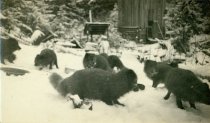Photo Catalog Record
Images

Metadata
Title |
Fox farm at Blank Island - close shot of foxes in the snow |
Image # |
2008.2.17.5 |
Object Name |
Print, Photographic |
Date |
1921-1931 circa |
Location |
Blank Island, Alaska |
Description |
Fox farm at Blank Island - close shot of foxes in the snow Based on a booklet written by William's wife, Mary Minthorn Strench (see provenance field for except related to the farm) both boys like to go to the island. Donald was the youngest boy and was born in 1921. The family left Ketchikan in 1931. Circa 1921-1931 for the farm. Ketchikan Alaska Chronicle article, 6/6/1922 "Fifteen Pairs Of Foxes Bought For Blank Isle Alfred Howe, for himself and W. G. Strench, has purchased fifteen pairs of blue foxes from the Lesoni Island farm, to be placed on Blank island. Howe and Strench with T. Handland, Sr., and T. Hadland, Jr., have a lease on Blank island. The two last named are now residing on the island and will have charge of the farm and the foxes. Others who have engaged in fox farming business are now preparing to put foxes on the island, so that next summer and the following year there will be many in the vicinity of Ketchikan ready for market." |
Provenance |
Booklet by Mary Minthorn Strench (daughter of Henry J. Minthorn - Quaker medical missionary to the Tsimshian in Metlakatla and wife of William Strench - Director of Immigration and Naturalization in Ketchikan.) Mary herself took her first teaching position in 1917 in Ketchikan prior to her marriage to William Strench. Excerpt from "Your Dad was a Great Guy" written by Mary Minthorn Strench in 1976 for her grandchildren regarding her son Donald Davis Strench Page 6 Among the many islands that lie along the coast of south-eastern Alaska is Blank Island, rugged, heavily wooded, and full of surprises. As an adventurous enterprise, the boys' dad, together with a partner, leased this island from the government for the purpose of raising blue foxes. As a business investment, the project encountered numerous hazards. There was a series of unusually wet winters, and frequent poachers - men who made a business of stealing from trappers and fur farmers. Then, only a few people were willing to live and work in such isolation, although the job provided a well-built house and fertile garden space. But whatever the fox farm lacked in the way of financial returns, it paid off handsomely in recreational values. The children loved it. The Beaver, a sturdy, seaworthy gas boat, was purchased by the partners. Someone - no one quite remembers who - said the craft resembled a pancake with a toothpick stuck in it. Nevertheless, it served to make the trips to and from the island carrying halibut heads from the cold storage as food for the foxes, and provisions for the tenants and the two families who rode in it. The Beaver became a delightful pleasure boat. The island was a paradise just waiting to be explored. At its center was a sizable lake covered with pond lilies. Many varieties of shells could be found in the underbrush, where they had been dropped and picked clean by the crows. There were no snakes, no poisonous insects to be encountered, although at times the small gnats called noseums could be troublesome. In their dad's rowboat the boys cruised around the protected side of the island, where at low tide brilliantly colored sea anemones made a fantastic garden under the clear water. Then at nightfall, the Beaver and its happy but slightly weary crew headed home, loaded with clams, fish and garden produce. |
Print size |
4 3/16 x 2 7/16" |
People |
Strench, William Strench, Mary Howe, Alfred Hadland, Jr., T. Hadland, Sr., T. |
Search Terms |
Fox Farm Fox farming Alaska Economic Resource Animal Animal, Wild |
Credit line |
Ketchikan Museums, KM 2008.2.17.5 |
